Hurricane Ian reinforced the value of rebuilding stronger, more resilient landscapes that respond to the temperamental climate. Groups such as Calusa Garden Club of Marco Island, Naples’ chapter of Florida Native Plant Society (FNPS), Sanibel Captiva Conservation Foundation (SCCF) and Naples Botanical Garden are doubling down on promoting species that thrive in sandy soil, stand up to salty wind and surge, and foster a healthy ecosystem.
The Garden’s conservation team is working to identify the best native and regionally appropriate plants to replenish beach dunes, which help prevent erosion and keep storm surges at bay. “We need to build back with diversity,” vice president of conservation, Chad Washburn, says. While native plants are often heartier, the issue is more nuanced. Shallow-rooted trees, like live oaks, can topple over in heavy storms, while the deep-rooted Cuban tamarind can stand the test of time. By request, The Garden works with the city and homeowners’ associations to guide on replanting strategies.
On Marco, Calusa Garden Club kicked off 2023 by planting a native gumbo limbo (great for wind protection) in Leigh Plummer Park and hosted a post-hurricane planting workshop with an FNPS master gardener in February. Further north, Sanibel’s SCCF Native Landscapes & Garden Center published the Post Hurricane-Ian Replanting Guide, with more than 50 Southwest Florida natives that fared well, like strangler figs and dune sunflowers.
The lessons are essential for residences, too. Goetz+Stropes Landscape Architects’ Ellin Goetz points to the native sabal palms she nestled along a Port Royal home’s waterfront. “They didn’t bat an eye with the inundation on that property,” she says. The trees stand up best in their natural form, with thick boots and fanning green fronds to catch the breeze, and planted in clusters with other natives. On Sanibel, Leigh Gevelinger, of Coastal Vista Design, plants wind- and salt-resistant gumbo limbos with tufts of silver saw palmettos for an extra buffer on coastal properties.
Perhaps most essential to Florida’s sensitive ecosystems: mangroves. If you’re lucky enough to live with them, Ellin urges embracing their natural form, creating vistas to look through the mangroves rather than cutting over them.





